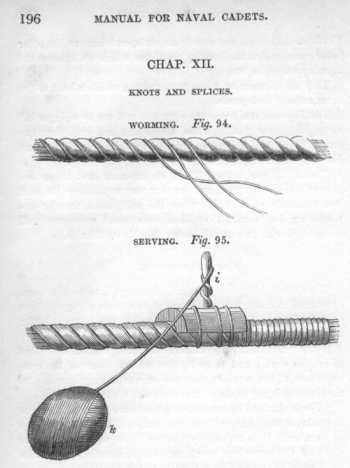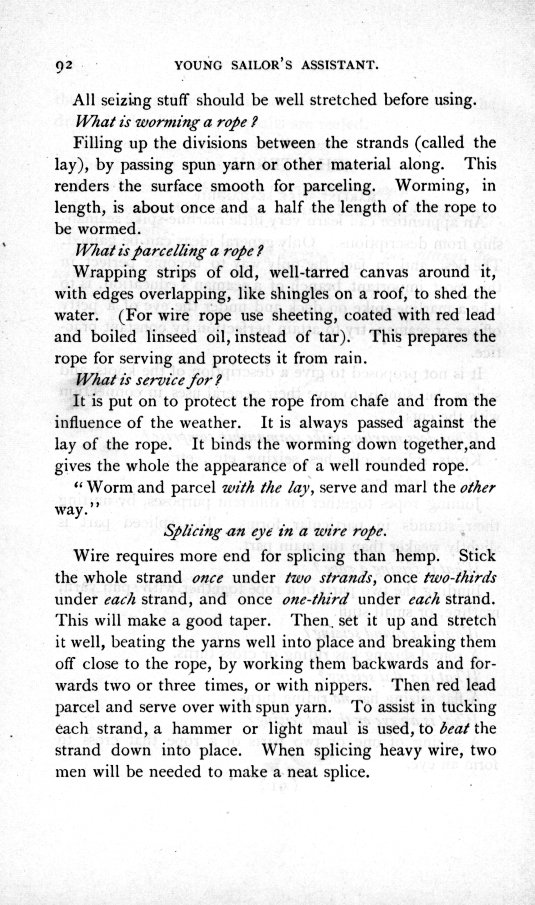Worm, parcel and serve
|
From Boyd, "Manual for Naval Cadets", 1857. |
En français: congréer, limander et fourrer; voir Le Manuel du Gabier.
In 1944, in his The Ashley book of knots Clifford W. Ashley (1881-1947) repeats the sailor's ditty:
Turn about and serve away.
and while this is the general rule (however, if the parcelling is not going to be served, it should go against the lay), this rhyme has been part of maritime lore since the nineteenth century as a reminder of a method to pervent chafe and to prevent water getting into rigging and causing rot. Very briefly, worming is filling the cracks or gaps petween the strands with yarn or other small stuff; parcelling is wrapping the rope with fairly narrow strips of old canvas; and serving is again wrapping with small stuff, rather in the manner of a continuous whipping. After this, tar or "marl" may be applied.
Protecting rigging against chafe and rot (particularly fresh, rain water) has been practiced for many centuries, but a recent "thread" on MarHst-l (Queen's University) asked for early use of the rhyme quoted by Ashley. An obvious way to start such research, was by browsing the John Harland and Stormy Weather fonds in our collections.
|
From Boyd, "Manual for Naval Cadets", 1857. |
Capt. (R.N.) John M'Neill Boyd first published "A manual for Naval Cadets" (London: Longman, Brown, Green, Longmans and Roberts) in 1857 for Royal Navy – and presumably merchant navy – cadets. It was one of the first text books for young men hoping to make a career at sea, predating the Admiralty Manuals of Seamanship. The last paragraph of page 136 (see image) states:
As there is really no other way of explaining which way to turn the yarn and canvas, (and that in the text, it is not given as a separate quote), it should probably be considered that the rhyming of 'lay' and 'way' is only fortuitous. Boyd's writing also misses the cadence of the later ditty. We therefore cannot retain this as the ditty.
The second edition of Boyd's manual was published in 1860, the year before he perished, as Captain of HMS Ajax, rescuing the crew of the Brig Neptune during a storm off Dun Laoghaire on the 9th of February 1861. Five of his crew were lost with him.
The copy of the first edition that we hold is dedicated by Captain Boyd to Sir Baldwin Walker (1812-1876), Surveyor of the Navy, "with the respectful compliments of the Author."
|
From Taunt, "Young sailor's assistant", 1857. |
Lieutenant Emory H. Taunt, USN, published his "Young sailor's assistant in practical seamanship including the rules of the road : directions for resuscitating the apparently drowned, etc., etc." in 1883 after it was approved and adopted by The US Navy Department, Bureau of Equipment and Recruiting.
At page 92 (see image), the second page of his Chapter V on Marline-spike seamanship, he writes: "Worm and parcel with the lay, serve and marl the other way." Note here that he puts it on a separate line and in quote marks; note also that the words scan poetically, and that while the wording is not eaxctly that of Clifford Ashley, the rythm is identical. We therefore retain this as the earliest published use of the sailorman's ditty that we have found, but will be happy to modify this opinion if an earlier example comes to light.
Lt. Emory Taunt (1851?-1891) is a somewhat obscure figure where his career in the US Navy is concerned. He was appointed to the Naval Academy 24 July 1865 and graduated as a midshipman on 4 June 1869. He served in the Mediterranean on the Sabine, flagship Franklin and the steamers Guerrière and Richmond. Promoted Ensign 12 July 1870, he served as such on the steamer Tuscarora, in the North and South Pacific Squadron from 1872 to 1874. Promoted Master, 28 December 1872, he served on the steamship Brooklyn in 1874 and the Shawmut in the West India Squadron, in 1876. He was commissioned as Lieutenant 15 August 1876, and ordered to duty at the Portsmouth Navy Yard. In 1884 Lieutenant Taunt was possibly detailed for the Greely Relief Expedition, but here his naval career becomes obscure. Later, in a better documented but less naval manner, he was involved with exploring the Congo River, becoming a commercial agent for the US Government and serving as envoy to King Leopold II in the Belgian Congo where he died bankrupt and in disgrace.


